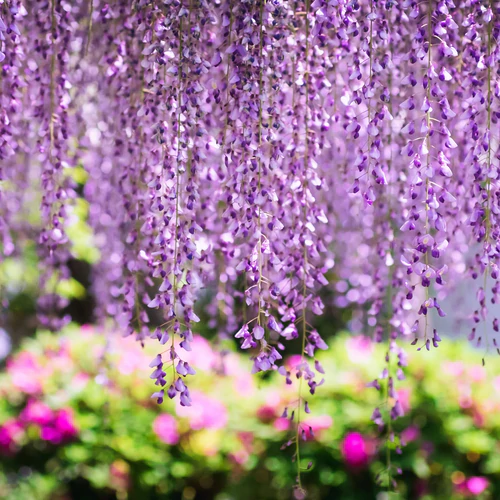While it may seem like a tree with its tall stance and long reach, Wisteria is a fast-growing vine capable of growing in many ways. Famous for its ability to cascade pergolas, archways and trellises. Wisterias drape shades of purple, pink, white and blue flowers creating a beautiful floral shelter wherever it grows.
About Wisteria
Ordinating in Asia, Wister belongs to the legume family. The leaves and the flowers have been cultivated for centuries for teas and stems to make paper. It is essential to know that the pods produced by Wisteria are highly toxic if consumed yet the flowers remain edible. You can find Wisteria in various variations of blooms and colours. However, there are two primary varieties of Wisteria.

Chinese Wisteria – Also known as Wisteria Sinensis, Chinese Wisteria originates from China. As a more extensive variety of Wisteria with strong climbing abilities, Chinese Wisteria is known to be an invasive species across many states. Reaching up to 60 ft tall and 15 ft wide, Chinese Wisteria can also grow indoors, reaching approximately 2 ft tall as a Bonsai Tree. Chinese Wisteria is the most popular variety of Wisteria available in shades of white, blue, pink and purple, all with different scents.

Japanese Wisteria – With more prominent and more scented blooms, Japanese Wisteria originates from Japan. They grow up to 35 ft tall and 25 ft wide. Japanese Wisteria uses surrounding objects like trellises to spread. With varieties of blooms in pink, white, blue, and purple shades. With proper care, this vigorous grower can reach up to 10 feet tall in just one year.
Planting Wisteria

Canadian Wisteria
In Canada, Wisteria can withstand a wide variety of temperatures allowing it to grow happily in zones 4 through 9. Initially, Wisteria will require protection from Canada’s harsh winters, but once matured, it will be able to take on the cold. Once planted, Wisteria can take up to 5 years to produce blooms. Beautiful Wisteria blooms can then appear for four to five weeks in and around May. Depending on the variety of Wisteria and growing conditions, a second bloom can sometimes occur in August!
Supporting Wisteria
When planting your new Wisteria vine, give your vine plenty of space from any objects you do not want it to climb on while also giving it the support it needs to grow to its fullest potential. If you choose to use a pergola, trellis or an arbour, it is crucial to ensure the structure’s weight is strong enough to host the Wisteria. A rule of thumb is to use support beams that are a minimum of 4 x 4 inches and made from wood or metal. To assist with the direction of growth, use strong garden twine while it matures to the top of your structure.
Wisteria Care
For more tips and tricks on how to grow Wisteria at home, check out the latest episode of Get Up and Growth with our President, Gord Nickel on Chek News below!


